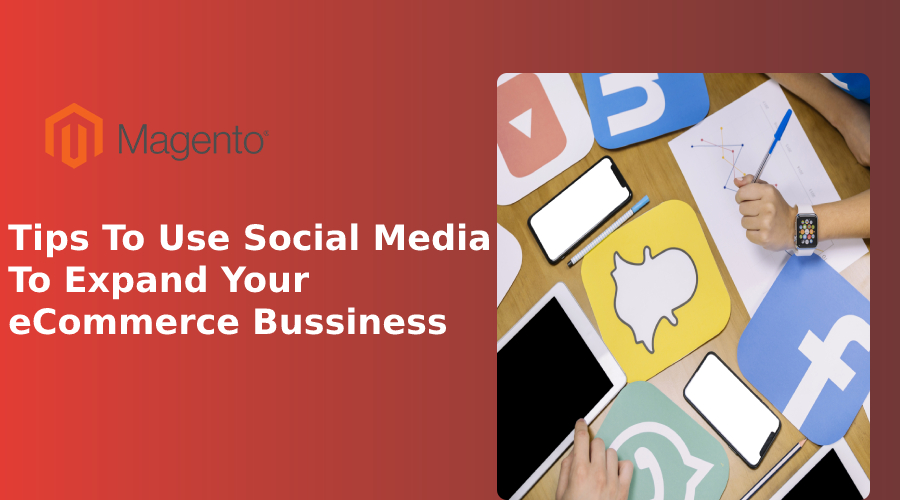
Regardless of your business, product, or service, social media and eCommerce have become inextricably linked. Setting up an online store isn’t enough to build your eCommerce business. “Build it and they will fade away long ago,” as the saying goes. You must now go where your consumers are, which is social networking.
Being in the social space may put your eCommerce store ahead of the competition, with the typical consumer spending 3 hours per day on social networks and messaging. Growing your email list, attracting and retaining new consumers, and solidifying your brand presence are all possible with social media.
There are a lot of ideas on how to utilize social media to develop your eCommerce shop, but the problem is that most of them are geared at companies with large internet budgets and brands that already have a large following.
We’ll go through all of the different methods you can utilize social media to promote your eCommerce company in this article. So, if you’re starting from scratch with your eCommerce social media presence or looking for strategies to refresh your marketing approach, you’ve come to the perfect place!
But first, let’s clear things up with a few definitions.
Table of Contents
I. What is Social Media?

A social media eCommerce strategy is a collection of social media methods for marketing your eCommerce store.
Your strategy may be focused on one or more of the following things, depending on your business model and objectives:
- Sending people to a website or branded app to promote an ecommerce destination,
- Directly selling things on social media,
- Pre-purchase and post-purchase communication with customers,
- Gaining knowledge about your industry (your audience, competitors, benchmarks for success),
… or mix and match some (or all!) of the above.
II. Is eCommerce Through Social Media The Same As Social Selling or Social Commerce?

Certainly not. The widest phrase of the three, social media e-commerce marketing, encompasses both social commerce and social selling features.
Let’s review some terms:
- Using Facebook Shops, Instagram Shops, Product Pins, and other native social media shopping solutions, social commerce refers to the process of selling products or services directly on social media.
- The practice of identifying, connecting with, and nurturing sales prospects using social media is known as social selling.
- Brand awareness, advertising, community management, social customer service, social listening, competitive analysis, social commerce, and social selling are all examples of social media ecommerce marketing.
III. Why Social Media Is Important To Grow Your eCommerce Store
As if it wasn’t already clear, social media has become an integral part of the omnichannel eCommerce marketing ecosystem. This is due to not only the platforms’ massive reach but also the enormous volume of traffic and sales that these channels generate.
“Social referral to retail eCommerce sites has surged 110 percent in two years, outperforming all other referral channels,” according to an eMarketer analysis on the state of social eCommerce in 2019. Because of the enormous power that these websites possess over online shops, merchants must learn how to develop a successful plan for utilizing the sales potential of each social media platform.
IV. 7+ Tips To Grow Your eCommerce Store By Using Social Media
Without further ado, let’s explore the experts tips to grow your online business using social media.
4.1. Make A Social Media Strategy

Before we get into influencer marketing, ads, and content ideas, let’s talk about a social media strategy, which is the most overlooked but crucial aspect of your eCommerce store’s social media success.
The majority of brands fail on social media due to a lack of a social media or content strategy. They’re mostly winging it, throwing content out in the hopes that someone will buy from them or that it will go viral.
To determine if their efforts are successful or a waste of time, energy, and money, retailers must specify the exact requirements for success. As a result, merchants should consider establishing benchmarks based on the following factors:
- The amount of traffic to be generated,
- The number of followers,
- Engagement rates,
- Conversions.
Other objectives can be stated by retailers, but these will be enough to start the brainstorming process.
Stop, take a breath, and begin developing a social media strategy. At Wishpond, we’ve seen firsthand how effective a good social media strategy can be for eCommerce businesses wishing to connect with their customers on a more personal level.
4.2. Provide Value

By publishing links to product pages on a regular basis, merchants will not develop an engaged audience. Users expect value from the pages they follow on social media. As a result, it is up to vendors to create content offerings that will benefit their following. This goal can be achieved by identifying the challenges, pain points, and interests that customers care about, and then producing content that addresses those issues, pain points, and interests.
This isn’t to argue that brands shouldn’t engage in promotional activities. Promotion is important, but it should be balanced out with a range of other articles that aren’t sales tactics.
When sellers do showcase their brand’s offerings, they must emphasize the company’s or items’ best and most unique features. Long-form content is one of the most effective ways to accomplish this.
4.3. Update Your Social Media Profiles

Keep your obsolete social media pages up to date by blowing off the dust. Customers want you to supply them with current information so that they can:
- Make contact with you.
- Check to see if you’re a credible eCommerce company.
- Learn how to shop from you.
It’s time to clean up your social media profiles if you have an old phone number or a broken link in your bio. Here’s a simple checklist to help you figure out what needs to be updated and what should be added to your profile if it’s missing.
Your eCommerce social media bio is a direct representation of your brand, so make sure it’s up to date. Followers are more likely to check the profile image before reading the username when searching. We are more drawn to pictures than words. It’s in our nature. If your profile bio has an old logo or an out-of-date image, it’s time to replace it with something more professional.
4.4. Start A Blog

For generating social sales, you’ll need a solid eCommerce content marketing plan. Despite its age, blogging continues to provide a fantastic stream of new information that can be used to inform, inspire, educate, entertain, and convert consumers into paying customers through social media. As you create your blog, include images, social media icons and links to your social network pages. Doing so will help readers easily find you on their preferred networks.
Furthermore, creating blog material can assist in transforming an online brand into a recognized thought leader in a specific niche, allowing the company to reach new heights.
4.5. Advertising

Recent statistics show that:
- 190 million people can be reached by Facebook advertising,
- 140 million people can be reached by Instagram advertising,
- 170 million people can be reached by LinkedIn advertising
… in the United States alone. (Source: Digital 2021 report by Hootsuite and We Are Social).
Of course, not all of them are your target audience, and reaching so many people will most likely be out of your budget.
However, most social media platforms have extensive targeting features that you can use to separate out your ideal audience from the crowd — and deliver them ads that will help you achieve your goals.
When it comes to goals, make sure you set the proper ones for your social media ads. You’ll probably want to employ social media advertising as an eCommerce firm to get people to your store, or a certain product or collection.
Brands can choose from three conversion-oriented objectives on Facebook and Instagram, for example:
- Conversions. You can use this goal to persuade your target audience to perform a certain action on your website, such as adding a product to their cart.
- Sales of catalogs. This goal can be used to insert products from your catalog into advertising.
- Traffic in the store. This ad goal is perfect for showcasing your store to possible clients who are in the neighborhood depending on their location if you have a brick-and-mortar location.
You can choose an objective from the Awareness or Consideration categories if you want to raise awareness or engage your target audience.
However, choosing the correct goal isn’t enough to guarantee success. You must also select the appropriate ad format for your campaign. The following are the main format categories on Facebook and Instagram:
- Image ads
- Video ads
- Carousel ads
- Collection ads
Collection commercials are created with eCommerce in mind. They attract your audience’s attention with a mix of creative content and goods from your product catalog, then effortlessly route them to checkout.
While Facebook’s ad platform is the most comprehensive, other social media networks provide similar services. So don’t worry if you use Twitter or LinkedIn to reach out to your customers on social media. In this guide to social media advertising, you can learn more about ad objectives and formats across platforms.
4.6. Post User-generated Content

This is a significant issue. Positive customer evaluations and comments are a sort of social proof, as we’ve already discussed. What’s more, do you know what’s even better? Content created by users.
Encourage your consumers to post photos and videos of their purchases on social media, identifying your company. Then, re-post these to your own social media accounts (crediting the author, of course).
Making your consumers feel visible strengthens your brand’s engagement with them. Customers that openly display your items on social media give you greater credibility in the eyes of new visitors (aka potential customers).
But wait, there’s more. When a client posts a photo or video of your product on social media, their followers may see it and engage with it. What better way to present yourself to new people than through real, organic recommendations?
4.7. Regularly Post
You’ll want your audience to keep you top of mind after your social media presence starts to acquire traction and you’ve built a following.
Staying visible and relevant requires a regular posting schedule. Also, without any material to interact with, how do you expect potential customers to interact with your brand?
4.8. Invest in Social Media Ads

As amazing as organic traffic and growth are, we can’t deny that they’re sluggish, and slow just doesn’t seem to work when you’re attempting to make x number of purchases per month.
On the other side, relying significantly on paid growth can result in a large number of followers but little engagement and only occasional sales. For your social media strategy, experienced social media managers recommend maintaining a good balance of paid and organic development.
Establish your ad budget before developing an ad or boosting a boost to track your social media ROI. Each social media site has its own set of best practices for getting the most bang for your buck. Take the time to become familiar with the social media ad landscape, particularly for platforms like Facebook, which is one of the most valuable pay-to-play social media platforms. Try to invest more in making Facebook ads to gain better results.
4.9. Improve Your Social Media Customer Service

It’s understandable if your primary social media goal is to attract new clients. But don’t forget about your current clients.
Even if you have a dedicated customer service team that communicates with customers via phone or email, social media will occasionally become an ad hoc customer service channel. Customers may visit your profiles to learn more about you, ask questions, or provide feedback. And when they do, you’ll need to be ready to deal with the incoming comments and direct messages.
The way you respond to questions on social media is just as important as the substance you share. Customers that are still in the consideration stage of their customer journey might use the opinions of pleased customers as social proof. You may demonstrate to your audience that you value and appreciate their opinion by engaging with comments.
What if the feedback you get isn’t positive? Treat negative feedback as an opportunity to offer answers and, once again, demonstrate that you value your consumers’ perspectives.
V. Conclusion
Keeping your eCommerce social media accounts up to date pays off in the long run. You can improve sales, interact with customers, and strengthen your brand presence on social media with appropriate strategy and consistency.
Thank you!














![[SALE OFF] Discount 30% Off All Products On Christmas And New Year 2024 Christmas & New Year 2024 sale off from Landofcoder](https://landofcoder.b-cdn.net/wp-content/uploads/2023/12/xmas-banner-900-x-500-px-3-218x150.png)





Interesting content. Thanks for sharing it.
Adobe Photoshop is the most demanding software for background removal services. You can use clippingpath.ai for background removal and photoshop retouching with manual clipping path techniques. They are friendly to work with